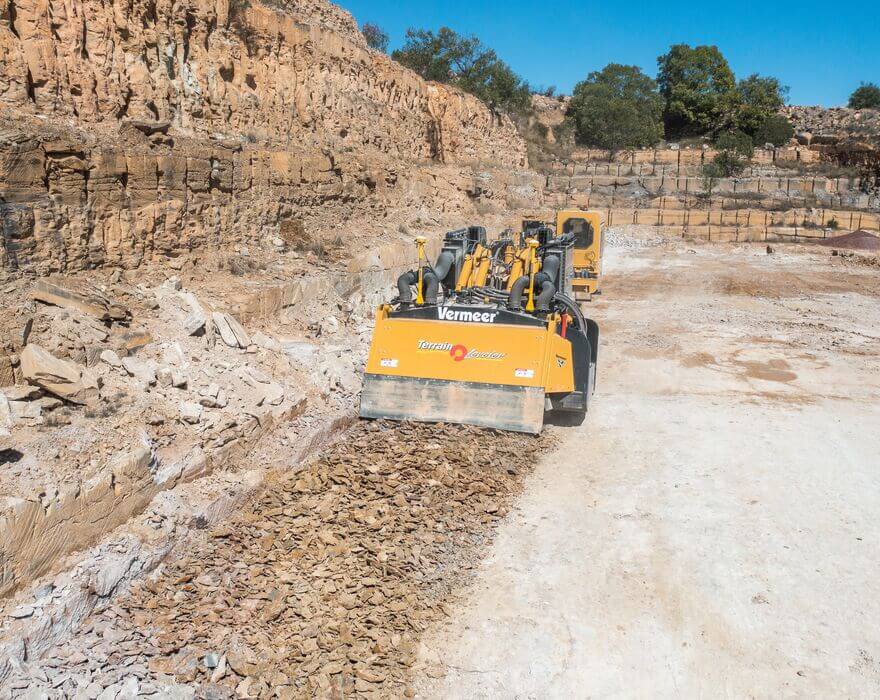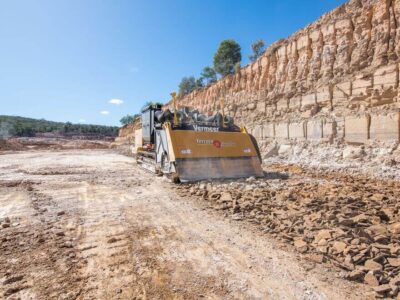Uneven terrain and blocked drill holes are ongoing challenges at many drill and blast mine sites. This common mining practice can produce rough terrain and narrowing of the mine floor. Also, sites that perform drill and blast mining often have issues with blast holes filling with water and debris after heavy rains. These common surface mining challenges can impact production.
Vermeer and its worldwide network of dealers have helped many leading mining companies overcome these common drill and blast mining issues. Vermeer Terrain Leveler® surface excavation machines (SEMs) have helped restore the mine floor and haul roads, while Vermeer vacuum excavators have efficiently cleared blast holes of moisture and debris.
Surface miners support maintenance on drill and blast mining sites
Over time, at many surface mines, walls can start to slope in, cutting off access to valuable material and mine floors. In addition, haul roads can become uneven, which can cause premature wear on mining equipment. That’s why many surface mining operations worldwide perform planned maintenance. They rent or invest in a surface miner to smooth out uneven mine floors and haul roads. Operations can also help restore sloping walls with the right machine. When equipped with a single-drive motor, the Vermeer T1255III Chain Drive Terrain Leveler SEM can effectively cut a 90-degree high wall to help with the issue.
Unlike large dozers sometimes used to maintain these areas, surface miners are designed for this work. Vermeer Terrain Levelers can also be equipped with GPS technology that can be used to create a mine-by-line plan with minimal operator involvement. This helps mines that primarily use drill and blast methods perform routine mine maintenance efficiently and get back to producing valuable material.
Accessing more mining areas with a surface miner
Restoring mine floors isn’t the only use for surface miners. These machines can also be used in areas where drill and blast mining cannot.
At many mine sites, there are areas where drill and blast isn’t a viable method of mining. Perhaps quality material is too close to a building, roadway or utility, and blasting could harm nearby infrastructure. In other instances, mines may be limited by how close they can mine near communities because of dust and noise concerns.
Surface miners excel in these areas of mining. Since this type of mining is done precisely using top-down cutting, material is sized and contained right where the work is happening. Dust and noise levels are minimized compared to those produced during drilling and blasting.
Operations can complement their drill and blast mining efforts with surface miners to maximize their results.

Vacuum excavators help miners get back to work sooner
To help minimize delays caused by weather, some drill and blast mines are adding vacuum excavators to their equipment fleets. Too often, a mine will drill out a section of blast holes only to have rain delay loading explosives. Vacuum excavators, like the extensive Vermeer lineup of trailer and truck vacs, can help teams get back to work quickly after weather events. These units deliver a powerful suction performance to remove water and spoils that may have found their way into holes during heavy rain.
Trailer vacuum excavators are nimble units that can be pulled around the mine site by a pickup truck. For mines with more significant needs, a Vermeer truck vac equipped with a large spoil tank provides more suction power to keep teams working.
Expand your mining possibilities
Vermeer may not be the first company you think of for mining machinery. But as the Vermeer team has done in many other industries, they do their research, identify the pain points of the professionals doing the work and develop new technology and equipment innovations to help companies work more efficiently. Vermeer has practiced that in the agriculture industry with the round baler, the utility industry with a full line of horizontal directional drills, trenchers and accessory equipment, the tree care industry with chippers and stump cutters, and the recycling industry with grinders.
Vermeer has worked in the mining industry for more than two decades, developing the innovative Vermeer Terrain Leveler SEM line. Vermeer surface miners and vacuum excavators can help you work efficiently and stay productive at your mine. To learn more, contact your local Vermeer dealer.
Vermeer Corporation reserves the right to make changes in engineering, design and specifications; add improvements; or discontinue manufacturing at any time without notice or obligation. Equipment shown is for illustrative purposes only and may display optional accessories or components specific to their global region. Please contact your local Vermeer dealer for more information on machine specifications.
Vermeer, and the Vermeer logo are trademarks of Vermeer Manufacturing Company in the U.S. and/or other countries.© 2023 Vermeer Corporation. All Rights Reserved.
